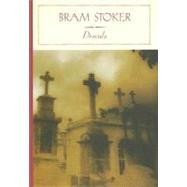
The New copy of this book will include any supplemental materials advertised. Please check the title of the book to determine if it should include any access cards, study guides, lab manuals, CDs, etc.
The Used, Rental and eBook copies of this book are not guaranteed to include any supplemental materials. Typically, only the book itself is included. This is true even if the title states it includes any access cards, study guides, lab manuals, CDs, etc.
Upon its publication in 1897, Bram Stoker's Dracula was seen as nothing more than a slightly cheesy thriller, if an unusually successful one. Most such "shilling shockers" were forgotten within a year or two. But this one was different: Over the course of the next century Count Dracula, the aristocratic vampire, left his natural habitat between the pages of a book and insinuated himself into the world's consciousness as few other fictional characters haveever done. Now, more than a hundred years after his appearance in print, Dracula has shed the status of "fictional character" altogether and has become an authentic modern myth.
Why has this odd and terrifying figure exerted such a hold on our collective imagination? Why does the image of the vampire both attract and repel, in apparently equal measure? If, as has been argued, Dracula owes its success to its reflection of specific anxieties within the culture, why then has its power continued unabated throughout more than a century of unprecedented social change? Late-Victorian anxieties and concerns were rather different from our own, yet the lure of the vampire and the persistence of his image seem as strong as ever.
Dracula's durability may in part be due to Tod Browning's 1931 film, for when most people think of the character, it is Bela Lugosi's portrayal that springs to mind. But in spite of memorable performances by Lugosi and by Dwight Frye as Renfield, the film is awkward and clunky, even laughable in parts; in terms of shocking, terrible, and gorgeous images, it cannot compare with the novel that inspired it. It is hard to believe that, on its own, it would have created such an indelible impact.
Once Dracula became lodged in the popular imagination, it began to accrue ever-new layers of meaning and topicality. The novel has provided rich material for every fad and fancy of twentieth-century exegesis. It has been deconstructed by critics of the Freudian, feminist, queer theory, and Marxist persuasions, and has had something significant to offer each of these fields. Today, in the age of AIDS, the exchange of blood has taken on a new meaning, and Dracula has taken on a new significance in its turn. For post-Victorian readers, it has been a little too easy to impose a pat "Freudian" reading on the novel, in which the vampire represents deviant, dangerous sexuality, while the vampire-hunters stand for sexual repression in the form of bourgeois marriage and overly spiritualized relationships. This interpretation certainly contains a large element of truth, but the novel's themes are much richer and more complex than such a reading might suggest.
Readers coming to Dracula for the first time should try to peel away the layers of preconception that they can hardly help bringing to the novel. We should try to forget Bela Lugosi; we should try to forget easy (and anachronistic) Freudian cliches; we should put out of our minds all our received twentieth- and twenty-first-century notions of friendship and love, both heterosexual and homosexual. If we let the novel stand on its own, just as it appeared to Bram Stoker's contemporaries in the last years of the Victorian era, what exactly do we find?
Excerpted from Dracula by Bram Stoker
All rights reserved by the original copyright owners. Excerpts are provided for display purposes only and may not be reproduced, reprinted or distributed without the written permission of the publisher.